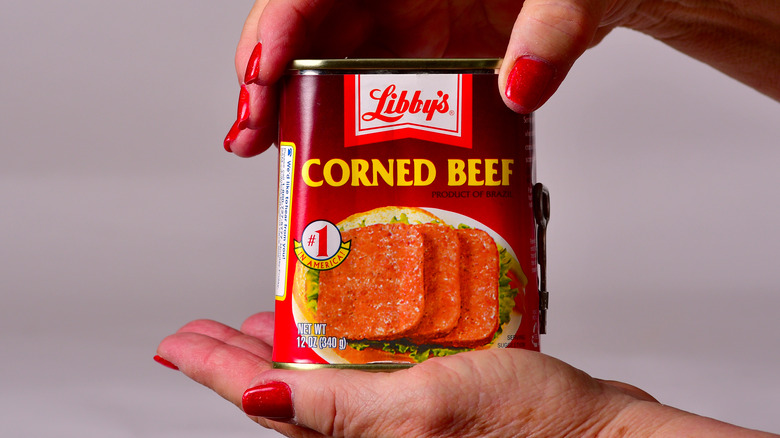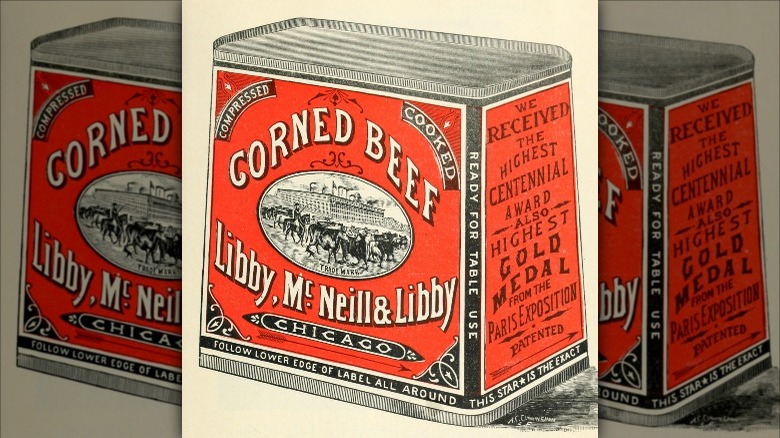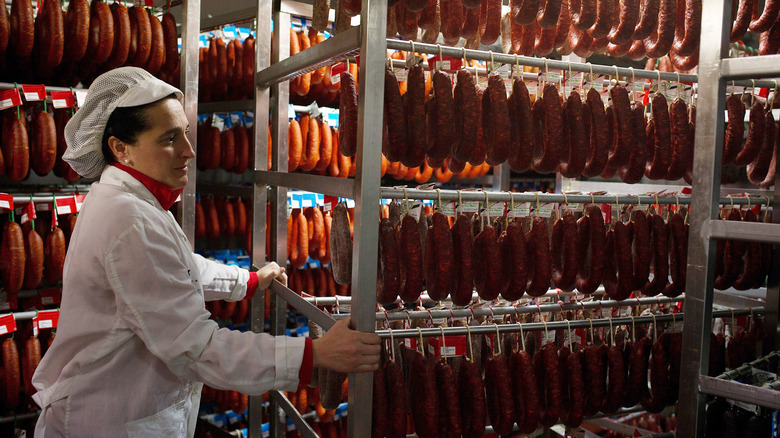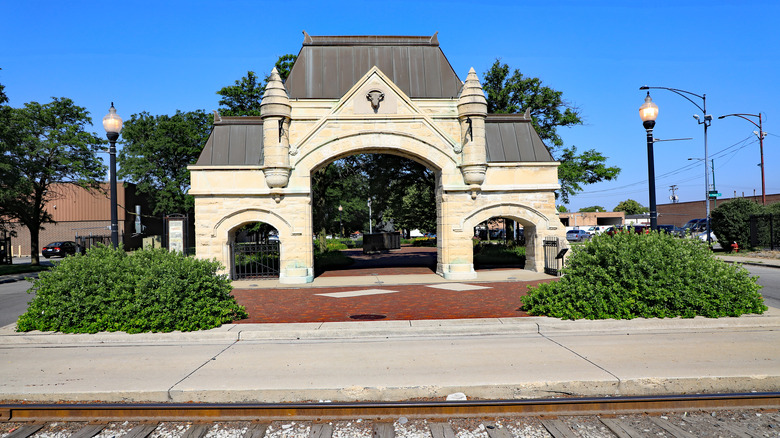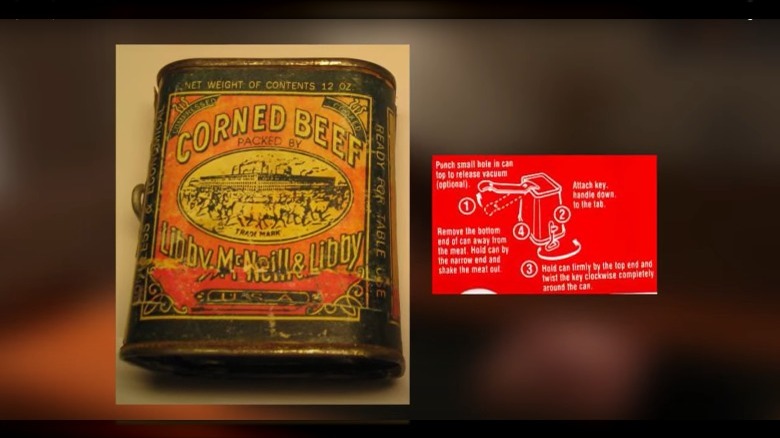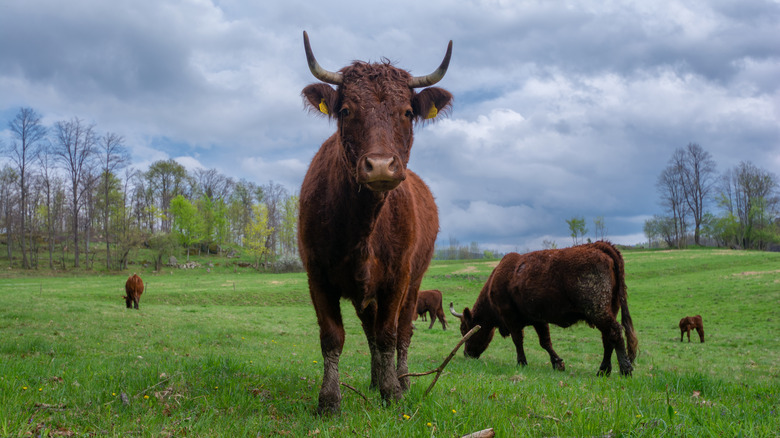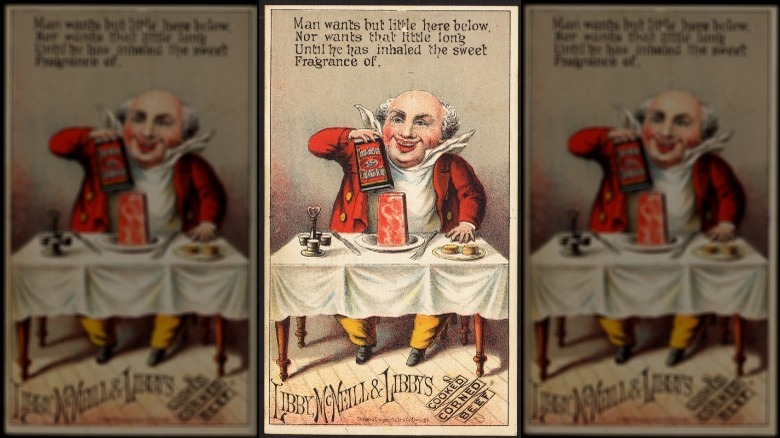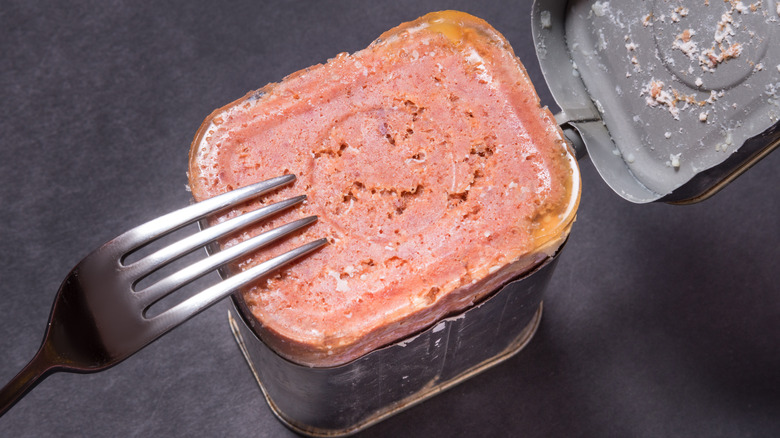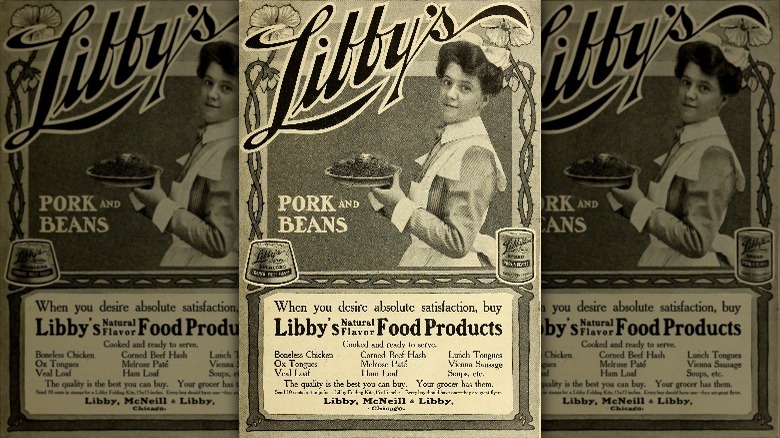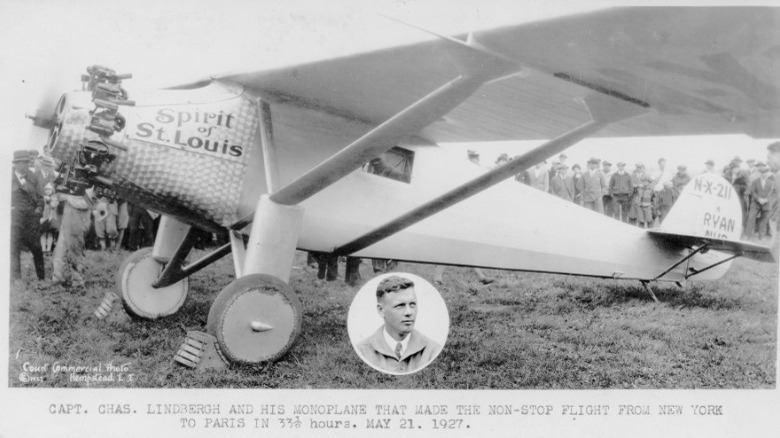Inside The Can: What We Know About Libby's Canned Corned Beef
If you are like us, you probably have reached out for a can of Libby's corned beef in your pantry on days when cooking elaborate meals seems like a battle. So what exactly is corned beef? You can eat it right out of the can like tuna or stuff it in a hard-shell taco and have a meal in no time. The versatile product, however, is much more than just a convenient pantry stock. For the past 150 years, the humble food has resiliently stood the test of time, even as those who invented it passed on and the company that debuted it expanded to include hundreds of other canned products (via Libby's).
Canned corned beef is most popular in the U.S., and Libby's might just be a favorite evening snack for some. For the world, though, it was the bellwether for the canning and preserving of meat, a participant in more than one pioneering expedition, and part of the emergency ration for those on the battlefield. This is the story of a canned food that's as old as the cans themselves.
Corned beef was Libby's first product
Libby's might remind you of that pumpkin pie you demolished the other day. After all, the brand's canned pumpkin accounts for 85% of all the canned pumpkin in the world (via Phys.org). But despite the mind-blowing statistics, pumpkin is not what made the company what it is today — it was, instead, the can of corned beef that you probably have stocked away in your cavernous kitchen shelf. In 1869, less than five years after the Civil War ended, Archibald McNeill and brothers Arthur and Charles Libby started Libby, McNeill, & Libby, offering one product — canned beef in brine, aka canned corned beef (via Libby's).
For the next four decades or so, the company was satisfied to keep selling canned corned beef. It was only in 1904 that Libby's started selling canned sauerkraut; three years later, condiments and fruits were added to its product offerings (via Libby's International). Today, there are over 150 products that the company sells, including juices, ketchup, sausages, and more. But none of it would have been possible without its first hit product, the canned corned beef.
It came out when cured beef was still not well known
You probably have noshed on enough prosciutto and salami to consider cured meat a common meal option. But curing meat — which means treating it with a blend of salt, sugar, and nitrites to up its shelf life (via The National Center for Home Food Preservation) — was not as popular post-1867. According to the book A History of the City of Chicago: Its Men and Institutions, meat was cured only during winter till then. So what happened?
In the summer of 1867, a certain gentleman named Arthur A. Libby (yes, the co-founder of Libby's — keep up!) showed that one didn't have to wait for the temperatures to dip to start curing the meat. It could be a year-round production. Libby's was founded shortly after this revelation and set the standards for preserving and packing meat. The beef was stuffed into cans and sealed airtight — a method that, per the book, no one had used until then to preserve meat. So, in a way, the lip-smacking grub paved the way for many of those other canned and cured foods that rest in your pantry today.
The meat was processed in a Chicago district that's now a historic landmark
Though Libby's was started in a small building on Chicago's State Street (via A History of the City of Chicago: Its Men and Institutions), it outgrew the facility in just a few years. Eventually, it expanded to the then-wildly popular meatpacking district in Chicago: the Union Stock Yards. A number of meat-processing plants, pens, and slaughterhouses came together to occupy a 450-acre swath of land that saw a whopping 13 million livestock sold annually in this district (via NPR). It changed the way Americans consumed meat (per WTTW) and brought in as many as half a million tourists annually (via NPR).
The idea of animal slaughter as a tourist attraction seems a little bizarre today, but it was big deal then. And Libby's and its corned beef were a part of this important history. Per A History of Chicago, Libby's operations spanned about 10-and-a-half acres in the multibillion-dollar livestock plant, with 2,500 employees helping churn out as many as 5 million cans of meat per month by 1901 (via Chaddick Institute for Metropolitan Development). Over the years, with the construction of highways and the launch of refrigerated trucks, the many processing plants clustered in the area for easy access to the railroad decided to disperse out to different locations (via Shaw Local News Network). And in doing so, they left what was once the pride of Chicago to be demolished in 1971.
Its packaging made it popular
Ever wondered why canned corned beef comes in a rectangular can? Many canned corn beef brands seem to prefer it over a simple round tin for their meat — be it Ox & Palm, Iberia, or Great Value, among others. Turns out, all of them were in some ways copying Libby's ingenious idea. In 1875, the founding trio of Libby's — Archibald McNeill and brothers Arthur and Charles Libby — introduced the rectangular can to pack the corned beef that they had been making since 1869 (via Chaddick Institute for Metropolitan Development). The can, co-invented by Arthur Libby and William J. Wilson (via Food Timeline), came with its own little key to remove the can lid. Phew! No fidgeting with can openers when using this one.
It was a hit, and according to the brand's website, it was the packaging that made it popular. But the real reason why the can avoided curves was because it was designed keeping the military in mind (via Foodhow.com). When transporting stacks of cans to Army stations, it was easier to efficiently stack rectangular cans one on top of the other rather than round ones, ensuring minimum wastage of space.
It has a high carbon footprint
You might want to put down your can of corned beef before reading this hard-hitting truth: When you are devouring that salted can of beef, you are not being very friendly to the environment. According to Green Choice Now, Libby's corned beef has a "very high" carbon and water footprint. But it's not just the brand in particular — beef and lamb are associated with high greenhouse gas emissions compared to, say, pork or chicken. A little more than 2 pounds of beef generates over 130 pounds of greenhouse gas emissions, per U.K. climate change website Carbon Brief (via Forbes), and one pound of beef requires 1,847 gallons of water for production, according to The Water Footprint Network (via Business Insider).
Then, of course, there is the cattle feed (grain, corn, etc.), which requires more land and resources. Per a study published in a scientific journal called "Animals," 13 pounds of feed is required for a quarter-pound hamburger (via Business Insider). To make all the food available for the bovines, large areas of forests are cleared to be used as pasture — a practice that affects ecosystems and aggravates climate change.
It earned gold medals at several world expositions
Back in the late 1880s, you would have been considered cool if you casually brought out a bright red can of Libby's corned beef for your guests. Not just because of the uniquely shaped can, or the fact that it was meat that didn't perish when left at room temperature — but that the product was world-famous; it had earned a name in international expositions, per Libby's YouTube Channel.
According to Libby's, its corned beef bagged the "highest gold medal" award in Paris back in 1878 — even before the Statue of Liberty was gifted by France to the U.S. or the Eiffel Tower rose on the Paris skyline. Yep, Libby's was popular in the French city before the French berets became popular in America. Over the years, Libby's expanded beyond Chicago throughout the rest of the United States, and by the 1920s and 1930s, it had built plants in England, Poland, France, and Germany (via Libby's).
But of course, you don't need to see a gold medal to appreciate Libby's canned corned beef; some quiet nosh time would do.
It can be eaten directly from the can
There is little else that equals the feeling of having ready-to-eat food after a long day of work. Libby's guarantees that comfort. The meat that's inside the can is cooked and ready to be consumed directly out of the can — you don't even have to heat it. It's good hot or cold, per GG Archives. While scooping it out with a spoon or fork is one way to eat it, you could also slice the block of meat into cubes and serve them as hors d'oeuvres — whether you jazz it up with some seasoning or opt for an already-flavored one — like corned beef with onion — is up to you.
Corned beef can be a star ingredient in your sandwich or hash. There are several good ways to eat canned corned beef (and some bad ways, too), whether it's with an egg or in a delicious appetizer. Plenty of recipes use it as the star of the show, and given its versatility and pre-cooked nature, it won't take long to turn a can into a full entrée.
It was used to feed the troops
Some Libby's corned beef cans have been in brutal places. All of the so-called doughboys (a nickname for American troops in World War I) had a can of Libby's corned beef in their emergency ration kit, per Libby's International. If you think about it, there couldn't have been an easier way for the Army folks to consume 130 calories conveniently. The innovative cans, as per Libby's, each had a key that had to be twisted to open the bottom of the can and slide the meat out.
Naturally, the product was popular among those on the battlefield; turns out, it wasn't just used by American troops, but by armies across the globe (via Digital Commonwealth).
The company's contribution to war efforts extends beyond feeding the Army. Libby's played its part in getting the world back on its feet after World War II by establishing plants in England, Holland, and Germany (via Libby's International) that could produce employment opportunities. In the Chicago area alone, the company provided thousands of jobs and brought in $100 million in sales in the 1930s.
It isn't really healthy
First, the good news: Corned beef contains a lot of good stuff that your body needs for functioning well, like protein, vitamin B12, iron, and selenium that's necessary for the growth of thyroid hormones (per Healthline). The bad news, however, is that a serving of Libby's corned beef contains 530 milligrams of sodium (via Libby's Meats), which, if you didn't already guess, is a lot. If you demolished a whole can, which is six servings, you would have inhaled a whopping 3,180 milligrams of sodium. This is way beyond what's recommended for adults — as per the Dietary Guidelines for Americans, salt intake should be within 2,300 milligrams per day, according to the U.S. Food and Drug Administration.
If you went beyond that intake, the added sodium will draw extra water into your bloodstream, thereby increasing your blood pressure and upping the risk of a heart attack, kidney disease, or blindness. In other words, too much corned beef is not good for your health. To put it even more plainly, the more you consume processed meat, the higher your risk of death (via Healthline).
The only consolation is that Libby's also sells corned beef with 25% less sodium in it (via Libby's Meats). With this one, you can enjoy a few extra servings without worrying (as much) about your heart.
A can of Libby's corned beef cost 23 cents a century ago
It's hard to imagine buying anything for less than a quarter today, but back in 1921, a full-blown breakfast of bread, eggs, and canned corned beef for a big family would have cost less than a dollar. As seen in ads from the time, a one-pound loaf of bread was priced at 5 cents, a dozen eggs, 35 cents (via Saucon Source), and a can of Libby's corned beef, a mere 23 cents (via Wilmette Historical Museum).
As per a 1921 grocery ad published in The Lake Shore News in Wilmette, Illinois, the product was "Very Cheap; No. 1 can" (via Wilmette Historical Museum). The ad further stated, "All those who know say that canned goods must be higher. Buyers have not placed contracts and manufacturers have not put up the goods. Buy now."
Taking into account the all-too prevalent phenomenon of inflation, a product that was worth 23 cents in 1921 should be worth $3.83 today. But when you drop a can of Libby's corned beef into your Walmart cart, you will pay close to $2 more — $5.67. So, while a can of Libby's canned beef definitely saw an uptick in price over the last century — during which it also switched ownership from Swift & Company to Nestle and then to Conagra Foods (via The Chicago Food Encyclopedia) — what we would never know is how much of a change it saw in its taste.
An old Libby's corned beef tin in now on display at a museum
Libby's corned beef has stood the test of time for over 150 years now. As much as it deserves a place in your kitchen cabinet, it also deserves a spot in a museum celebrating American history. A can of Libby's corned beef is part of the collection at the National Museum of American History in Washington, D.C. The tiny metal can is among the many other exhibits of value — including paintings depicting the scenes from World War I by America's first official war artists, the now-obsolete indoor portable tubs that were a trend in the early 19th and 20th centuries, and a Titanic life vest.
Yet another throwback item related to Libby's corned beef that's part of a museum collection is a wooden crate that was used to transport the cans of corned beef back in the day. The leather-handled crate that has probably traveled around the world now has a home at the National Museum of African American History & Culture.
Libby's corned beef has been part of pioneering expeditions
Today, it's possible to have breakfast in Paris and dinner in New York on the same day, in part because of the pioneer aviator Charles Lindbergh. Filling your Insta grid with dreamy travel clicks wouldn't have been possible if not for Lindbergh and his interest in exploring flight routes across the world. While Lindbergh's claim to fame was completing the first solo flight trip from New York to Paris, crossing the Atlantic Ocean in 34 hours (via Space.com), he'd also explored different international routes alongside his partner Anne Morrow Lindbergh (via the National Air and Space Museum).
But what has that got to do with Libby's? Turns out Libby's canned corned beef was among the emergency rations (the other items included a primus stove, pot, and canned tomatoes) that the Lindberghs carried with them on their flight adventures, per the Pioneers of Flight Gallery. This means Libby's corned beef was probably part of the very first flight that charted the path from Newfoundland to Europe. But the product, it turns out, went on more adventures than one. According to Libby's, cans of corned beef were also part of Admiral Richard Byrd's expeditions to the North Pole in 1905.
